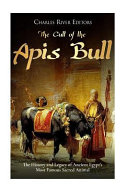Product desciption
The Cult Of The Apis Bull The History And Legacy Of Ancient Egypts Most Famous Sacred Animal Charles River Editors by Charles River Editors 9781982073527, 1982073527 instant download after payment.
*Includes pictures *Includes ancient accounts *Includes online resources and a bibliography for further reading Africa may have given rise to the first human beings, and Egypt probably gave rise to the first great civilizations, which continue to fascinate modern societies across the globe nearly 5,000 years later. From the Library and Lighthouse of Alexandria to the Great Pyramid at Giza, the Ancient Egyptians produced several wonders of the world, revolutionized architecture and construction, created some of the world's first systems of mathematics and medicine, and established language and art that spread across the known world. With world-famous leaders like King Tut and Cleopatra, it's no wonder that today's world has so many Egyptologists. Perhaps the most intriguing aspect of ancient Egyptian civilization was its inception from the ground up, as the ancient Egyptians had no prior civilization which they could use as a template. In fact, ancient Egypt itself became a template for the civilizations that followed. The Greeks and the Romans were so impressed with Egyptian culture that they often attributed many attributes of their own culture - usually erroneously - to the Egyptians. With that said, some minor elements of ancient Egyptian culture were, indeed, passed on to later civilizations. Egyptian statuary appears to have had an initial influence on the Greek version, and the ancient Egyptian language continued long after the pharaonic period in the form of the Coptic language. To the ancient Egyptians, the gods and goddesses were all around them and could be seen daily in nature. Nearly every animal found in ancient Egypt, both domestic and wild, were associated with a god or goddess, which can be seen in Egyptian art where deities are often depicted with human bodies and animal heads. Or sometimes the deities are portrayed as complete animals. Since deities were associated with certain animals, all animals of a specific species were given divine and protected status. The reverence that ancient Egyptians had for certain animals evolved during the long duration of Pharaonic history until by the Late Period animals of specific species were mummified by the thousands as offerings for their associated deities. For instance, ibises were mummified for the god Thoth, while cats were mummified for the goddess Bastet. Modern archaeologists have uncovered most of the Late Period animal mummies in the region near the modern village of Saqqara, which has become known as the "Sacred Animal Necropolis." Although most of the animal mummies discovered in the Sacred Animal Necropolis of Saqqara are the thousands of nameless ibises, falcons, crocodiles, and cats, the region was also home to another, more important animal cult. By the time the Greeks took control of Egypt in the late 4th century BCE, the Apis cult was certainly one of the most influential, if not the most influential, of all the many different religious institutions that existed in the country at that time. Through a combination of modern archaeological excavations as well as Egyptian texts and classical historical accounts, the meaning, scope, and importance of the Apis cult can be better understood.


